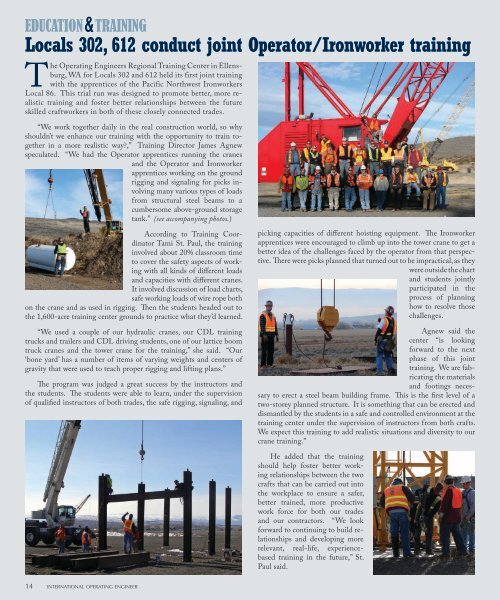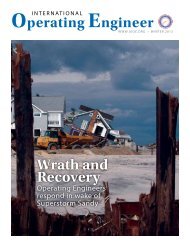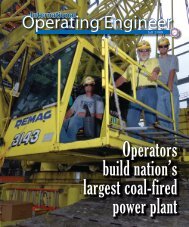Summer 2009 - International Union of Operating Engineers
Summer 2009 - International Union of Operating Engineers
Summer 2009 - International Union of Operating Engineers
Create successful ePaper yourself
Turn your PDF publications into a flip-book with our unique Google optimized e-Paper software.
&<br />
e d u c at i o n t r a i n i n g<br />
Locals 302, 612 conduct joint Operator/Ironworker training<br />
The <strong>Operating</strong> <strong>Engineers</strong> Regional Training Center in Ellensburg,<br />
WA for Locals 302 and 612 held its first joint training<br />
with the apprentices <strong>of</strong> the Pacific Northwest Ironworkers<br />
Local 86. This trial run was designed to promote better, more realistic<br />
training and foster better relationships between the future<br />
skilled craftworkers in both <strong>of</strong> these closely connected trades.<br />
“We work together daily in the real construction world, so why<br />
shouldn’t we enhance our training with the opportunity to train together<br />
in a more realistic way?,” Training Director James Agnew<br />
speculated. “We had the Operator apprentices running the cranes<br />
and the Operator and Ironworker<br />
apprentices working on the ground<br />
rigging and signaling for picks involving<br />
many various types <strong>of</strong> loads<br />
from structural steel beams to a<br />
cumbersome above-ground storage<br />
tank.” (see accompanying photos.)<br />
According to Training Coordinator<br />
Tami St. Paul, the training<br />
involved about 20% classroom time<br />
to cover the safety aspects <strong>of</strong> working<br />
with all kinds <strong>of</strong> different loads<br />
and capacities with different cranes.<br />
It involved discussion <strong>of</strong> load charts,<br />
safe working loads <strong>of</strong> wire rope both<br />
on the crane and as used in rigging. Then the students headed out to<br />
the 1,600-acre training center grounds to practice what they’d learned.<br />
“We used a couple <strong>of</strong> our hydraulic cranes, our CDL training<br />
trucks and trailers and CDL driving students, one <strong>of</strong> our lattice boom<br />
truck cranes and the tower crane for the training,” she said. “Our<br />
‘bone yard’ has a number <strong>of</strong> items <strong>of</strong> varying weights and centers <strong>of</strong><br />
gravity that were used to teach proper rigging and lifting plans.”<br />
The program was judged a great success by the instructors and<br />
the students. The students were able to learn, under the supervision<br />
<strong>of</strong> qualified instructors <strong>of</strong> both trades, the safe rigging, signaling, and<br />
picking capacities <strong>of</strong> different hoisting equipment. The Ironworker<br />
apprentices were encouraged to climb up into the tower crane to get a<br />
better idea <strong>of</strong> the challenges faced by the operator from that perspective.<br />
There were picks planned that turned out to be impractical, as they<br />
were outside the chart<br />
and students jointly<br />
participated in the<br />
process <strong>of</strong> planning<br />
how to resolve those<br />
challenges.<br />
Agnew said the<br />
center “is looking<br />
forward to the next<br />
phase <strong>of</strong> this joint<br />
training. We are fabricating<br />
the materials<br />
and footings necessary<br />
to erect a steel beam building frame. This is the first level <strong>of</strong> a<br />
two-storey planned structure. It is something that can be erected and<br />
dismantled by the students in a safe and controlled environment at the<br />
training center under the supervision <strong>of</strong> instructors from both crafts.<br />
We expect this training to add realistic situations and diversity to our<br />
crane training.”<br />
He added that the training<br />
should help foster better working<br />
relationships between the two<br />
crafts that can be carried out into<br />
the workplace to ensure a safer,<br />
better trained, more productive<br />
work force for both our trades<br />
and our contractors. “We look<br />
forward to continuing to build relationships<br />
and developing more<br />
relevant, real-life, experiencebased<br />
training in the future,” St.<br />
Paul said.<br />
14<br />
i n t e r n at i o n a l operating e n g i n e e r













